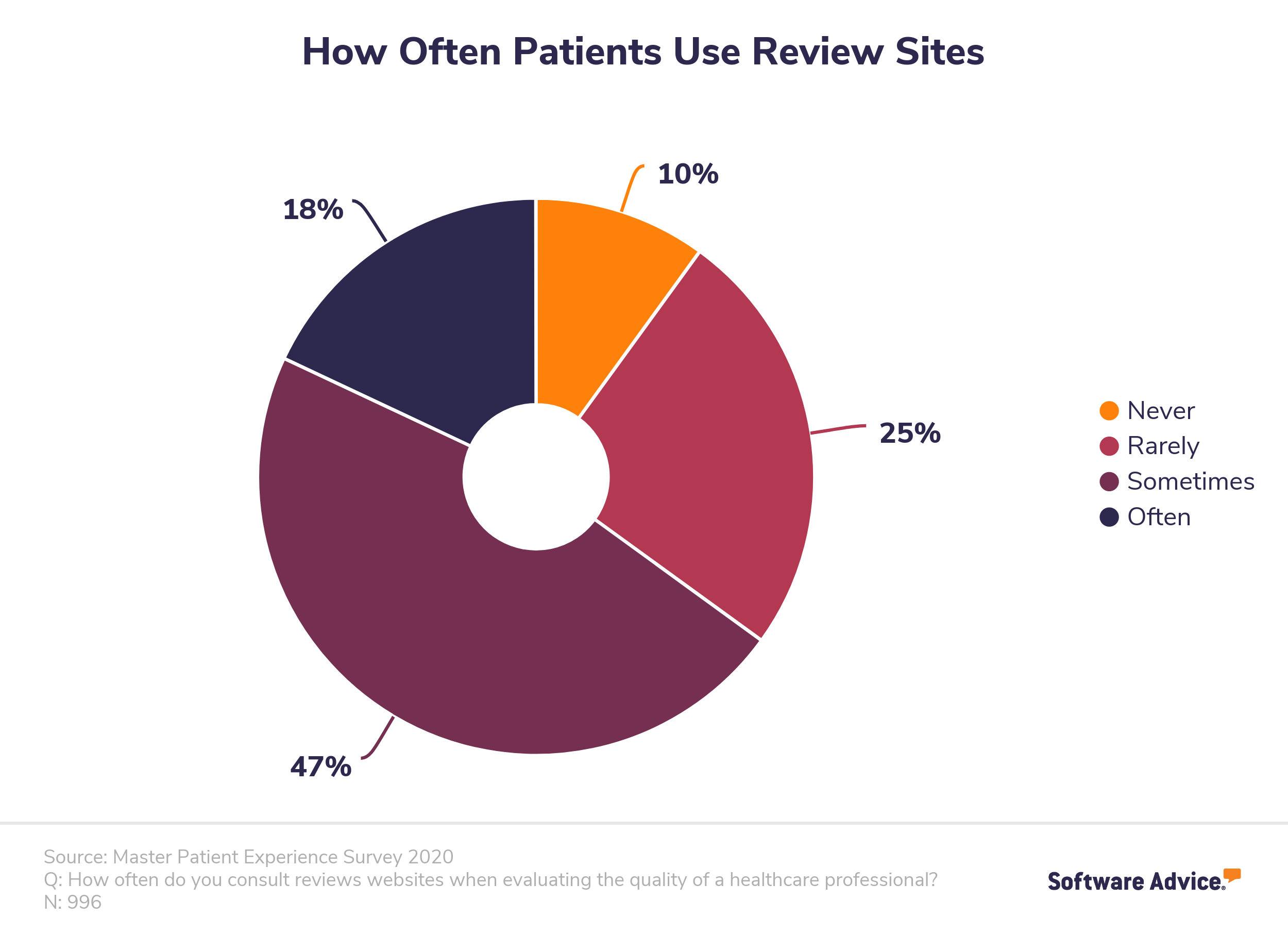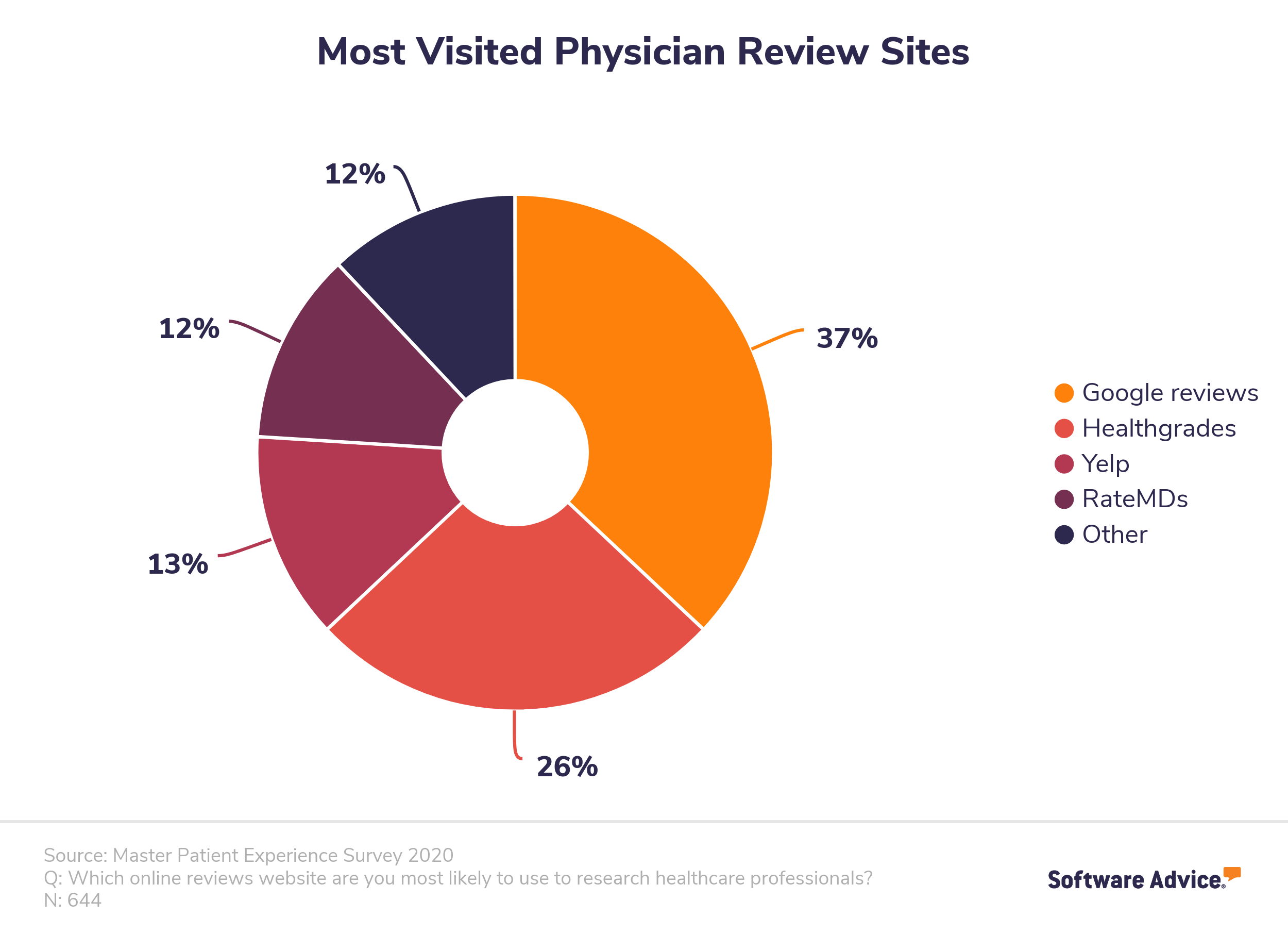A typical patient interacts with a medical practice online at least nine times before deciding to book an appointment. The more online touchpoints a physician has, the more effective their marketing is. If your prospects can’t find you on Google or in online directories, they are less likely to find your website and book an appointment with you.
Before patients step in the front door of your practice or your online office, they can interact with you through different methods and channels (online, offline, phone calls, messages, etc.), assess your online presence, see how easy it is to find you in search results, gauge the quantity and quality of patient reviews (your online reputation), and see whether your communications appeal to them and answer their questions. That’s why it’s vital to optimize all channels of communication to drive more appointments.
Learn what the patient’s digital journey is and how it can help you effectively reach patients in this blog post.
What is the patient’s digital journey?
The patient journey refers to a patient’s experience moving through the healthcare system and interacting with each entity along the way.
Let’s look at the most common example of a patient’s digital journey. Most patients begin their journey with the realization that there’s something wrong with their well-being and that they might need some help. The first step is going online and googling their symptoms. After they determine the problem, they move on to researching physicians, scheduling an appointment, meeting online or offline, evaluating their experience, and writing a review.
If you’re concerned about your medical marketing strategy and providing an outstanding patient experience, it’s high time you optimized how your practice fits into this digital patient journey and how you communicate with your prospects at each stage.
Stages of the patient’s digital journey
It’s impossible to consider all relevant scenarios, as there are too many and they’re too complex. However, we’ve tried to describe the most common scenario of a patient seeking the help of a physician via digital channels.
There are five main stages on the patient’s digital journey, and each is an opportunity to deliver an exceptional experience.

Stage 1. Awareness and research
At this stage, the patient feels that something is wrong and becomes aware they have a problem. The most common motivations to take action are physical or emotional pain. The patient decides to take action and starts looking for answers. Patients who have a vague knowledge of their issue turn to the internet for further information.

This research process can take from hours to months depending on the situation and the person. People can start by looking for broad keywords like “headaches” and are generally directed to websites such as MyHealthfinder, WebMD, Wikipedia, The Mayo Clinic, or popular medical blogs. After in-depth research, some will move to choosing a relevant specialist or clinic, while some will self-diagnose and try to address the issue themselves, which sometimes even leads to buying illicit drugs online.
How to connect with prospects at this stage
Websites used for research by prospects at this stage (Wikipedia, WebMD, MyHealthfinder, etc.) have so much authority (in terms of SEO) that it’s nearly impossible to compete with them and hope to outrank them in search results. For this reason, it’s better to concentrate on other stages of the customer journey.
Stage 2. Assessing healthcare options
After your prospects have identified an issue, they are likely to search for healthcare services online to help them address it. This is where your digital marketing activities can have the biggest impact on patient acquisition.

How to connect with prospects at this stage
The quality of your communication has a direct influence on your medical practice’s success from the moment a patient starts looking online for a service or a referred provider. Below are the most common channels you can communicate through.
Website
A website helps you get found by potential patients and sell your services. A website can help you create a robust online presence and brand, connect with prospects, inform visitors about your services, convert potential leads, and more. Your website is the heart of your digital marketing strategy.

Here is how to communicate effectively through your website:
- Make navigation easy and clear
- Make sure you have a mobile version of the website
- Describe your services in detail and provide information about any tests that are needed
- Provide times and cost estimates for your services
- Add alternative communication channels (live chat)
- Enable online appointment scheduling
Your clients are more likely to stay with you if your website is patient-centric and helps them find necessary information and solve their issues.
Search engine optimization (SEO)
As we mentioned above, your website is the bridge that connects you and your clients. Search engine optimization (SEO) can help people find your website when they’re searching for services you provide.

Local SEO can be a great boost for your medical practice, helping you show up in local Google searches. Make sure you invest enough time studying SEO and its opportunities. SEO involves a number of things, from setting up a Google My Business page to optimizing keywords, cultivating online reviews, and ensuring consistency in local citations.
Here are some quick steps to make sure your SEO works for you:
- Set up a Google My Business page and fill out your profile completely.
- Explore relevant keywords and make use of on-page SEO to optimize your website’s pages and posts.
- Start building backlinks to your website by contributing guest blog posts on other websites, getting listed in online directories, etc.
- Research keywords in your niche to see what queries you can rank for.
- Begin writing content (landing pages and blog posts) that your ideal client will be searching for and add that content to your website each month.
Tools like Keyword Planner and Google Trends by Google can help you with planning your SEO strategy. Besides, Google has done a great job with onboarding, so make sure you check out their help center.
Directories and review sites
Prospects can also find your website through business listings and directories such as Google My Business, Yelp, and medical-specific directories. These websites usually appear at the stage between the prospect’s search query and visiting your website. According to the Master Patient Experience Survey 2020 by Software Advice, almost half of respondents frequently use online reviews, and this percentage is growing.

We recommend creating a profile on the most popular directories, providing high-quality photographs of you and your office, and making sure you add a relevant description of your practice and keywords to enhance your chances of getting found.
Paid ads
Since your prospects will search for you online, one of the most effective ways to reach these potential patients is via paid online advertising. Digital advertising is essential for driving leads and generating new patients for high-revenue services, but it is also quite competitive.
According to eMarketer, the US is the world leader in healthcare advertising expenditures.
Google and Facebook Ads are the two most common forms of online advertising. When you advertise on Google and Facebook, your prospects will see your ads in Google search results and in their Facebook News Feed, respectively.
Paid advertising isn’t rocket science. Still, it requires much investment in the form of time, effort, and money. Besides, there are some ethical and legal considerations you should be aware of while setting up an ad campaign. We recommended contacting a specialist who will help you set up an ad manager, create an ad content plan, set metrics, and launch your ads correctly.
Stage 3. Booking an appointment
As soon as a patient chooses your practice over competitors, they want to immediately fix an appointment with you. To ensure that your prospects convert and become your patients, offer online scheduling options. Online scheduling is a major deciding factor when choosing among competing options. A study by Stax conducted on behalf of Healthgrades found that about 80% of patients prefer a physician with online scheduling over one without. Thus, it’s best to offer a self-service option to make this stage easier, faster, and more patient-friendly.
How to connect with prospects at this stage
With a booking page, your patients get full control over booking an appointment and can schedule an appointment when it’s convenient for them without playing phone tag. At the same time, you get rid of time-consuming administrative tasks and can devote more time to your patients.

A booking page communicates your services, availability, and prices better than anything or anybody else. To make your communication even more successful, make sure your booking software can send automated reminders to patients before an appointment. This will help reduce no-shows and last-minute cancellations. Ask patients about how they want to get appointment reminders: via phone call, SMS, or email.

Finally, it’s good to have registration and intake forms at this stage so as not to waste time on this at your appointment.
Stage 4. Going to the appointment
An appointment might be held offline or online. If you meet your patients offline, the communication at your front desk is of vital importance, so make sure your staff is polite, attentive, and focused on your patients. A great experience at this stage encourages patients’ loyalty towards your practice.
If the appointment is online, it’s great to have telemedicine software. Let’s see in detail how telemedicine software can enable smooth communication.
How to connect with prospects at this stage
To provide a great experience, your telehealth tool should be user-friendly both for patients and providers. For your comfort, make sure you have all the necessary features in one place. Nowadays, there is software that combines scheduling, online booking, automated reminders, video calls, chat functionality, patient management, billing, and health records management. For a great patient experience, such telemedicine software also allows for a smooth connection with a physician via a link. This feature set decreases time spent on administrative tasks, eliminates app juggling, and boosts patient satisfaction.

At your online meeting, use telehealth software to connect with your patient via video. Adjust the camera angle and lighting so the patient can see you clearly, check your microphone, and free your office from noise and visual distractions.
During the appointment, exchange relevant records and tests in a secure and encrypted chat. These techniques aid in creating a smooth and memorable patient experience, therefore increasing patient retention and providing a fantastic opportunity for favorable online reviews.
If you’re interested in software that can do all the above and even more for you, take a look at ExpertBox. It’s a one-stop solution that has booking features, online intake forms, automated reminders, video calls, chats, and other necessary features to run your practice. Try ExpertBox for free and see how it can streamline your custom workflow at each phase of care delivery.
Stage 5. Evaluating the patient experience and giving feedback
After the appointment, it’s good to ask a patient to provide feedback on what was good and what needs improvement. Online reviews are a driving force for 81% of patients who are looking for physicians online. To realize how positive feedback is important for your medical practice’s success, take a look at the following statistics collected by Software Advice:
- 94% of respondents evaluate physicians in part by looking at their online reviews. Reading reviews is an easy first step for prospective patients to get a feel for your practice.
- For 72% of respondents, assessing online reviews is the first step in finding a preferred physician.
- Almost half (48%) of respondents say they’d consider going out of network to see a physician with favorable reviews.
- 70% of respondents feel it is at least moderately important for there to be a public response to online patient reviews. Direct, HIPAA-compliant responses are often the most effective way to deal with negative reviews.
For your potential patients, it’s enough to scan one to six reviews to form an opinion about your practice. However, a single bad review can deter numerous prospective patients. That’s why you need to keep an eye on your online reputation and answer negative reviews promptly.
According to the Master Patient Experience Survey 2020 by Software Advice, the most popular medical directories include Google reviews, Healthgrades, Yelp, and RateMDs:

Another thing that online reviews can help you with is patient retention. By being a proactive specialist and asking for feedback in your communication, you can see areas that need your immediate attention.
Let’s see what review channels matter and how to ask patients to leave feedback.
How to connect with prospects at this stage
Encourage reviews and testimonials by adding online review links on your website. After an appointment, you can ask for a review during a follow-up phone call, text message, or email.
Places for patients to leave reviews:
- Google My Business. Google My Business includes vital business information, photos, reviews, and ratings. Use it to effectively manage your online presence across the entire Google ecosystem.
- Yelp. Yelp is a popular review channel with more than 192 million reviews, 8% being health provider reviews. Medical reviews are the sixth most popular category on Yelp. You can be sure your prospective patients will check them out.
- Healthgrades. This popular review channel features more than 1 million provider profiles and 7 million reviews. It’s easy to claim your Healthgrades profile, and it’s possible to promote your practice through the Healthgrades advertising program.
- Facebook. Facebook helps physicians connect with existing patients as well as to attract new ones. Moreover, users can leave comments and likes, which serve as additional proof of a physician’s professionalism.
Summing up
Medical practices that take care of communication at each step of the patient’s digital journey are more likely to boost patient satisfaction and loyalty, which are essential for long-term practice success. Embrace the available options to optimize your communication with prospects:
- Create a professional, consistent image across the web with the help of your website, directories, and reviews.
- Use Google My Business to its maximum potential.
- Create or extend your blog with carefully chosen subjects and keywords.
- Use efficient SEO techniques.
- Consider using paid ads to attract prospects to your practice.
- Offer a self-service online booking form.
- Opt for online appointments and video calls.
- Keep an eye on your reputation and ask your patients to leave feedback on the service they’ve received.
Subscribe to our newsletter to get more tips on marketing for medical practitioners.




